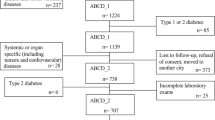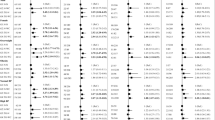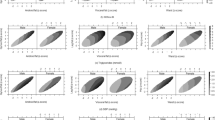Abstract
OBJECTIVE:To quantify the effects of fasting lipids, age, apolipoprotein (apo) E polymorphism, insulin resistance, body fat and abdominal fat distribution, on postprandial lipemia (PPL) in non-diabetic obese women.
DESIGN:Cross-sectional, prospective.
SUBJECTS:A total of 93 obese women (mean±s.d. age 39±13 y; body mass index (BMI) 38.3±4.9 kg\m2) and 16 nonobese women (25±8 y; BMI 22.7±3.2 kg\m2).
MEASUREMENTS:Body fat distribution was determined by the ratio of waist-to-hip circumferences (WHR) and by computed tomography (CT) at the L4-L5 level. Apo E genotyping was performed by restriction isotyping. Insulin resistance was calculated from fasting glucose and insulin concentrations. PPL was evaluated using the vitamin A-fat tolerance test (1.0 g fat\kg body weight and 7.0 mg cholesterol\kg body weight+300 000 IU vitamin A palmitate). Blood samples were drawn before, and every 1.5 h for 7.5 h plus 24 h after ingestion of the fat meal. Areas under the response curves (AUC) for triglycerides (TG) and retinyl palmitate (RP) were calculated using the geometrical method for two time intervals, that is, 0–7.5 h and 0–24 h.
RESULTS:Incremental AUCs TG, but not AUCs RP, were increased in the obese women. Apo E polymorphism, BMI, WHR and menopausal state did not influence PPL in the obese women. Fasting TG, age, the intra-abdominal to subcutaneous abdominal fat ratio (IA\SC ratio) and insulin resistance were independent determinants of PPL. Together, fasting TG, IA\SC ratio and insulin resistance, explained 38% of the variance in AUC TG 0–7.5 h (P=0.0001).
CONCLUSION:Alterations in PPL are to be added to the increasing number of components of the plurimetabolic syndrome.
This is a preview of subscription content, access via your institution
Access options
Subscribe to this journal
Receive 12 print issues and online access
$259.00 per year
only $21.58 per issue
Buy this article
- Purchase on Springer Link
- Instant access to full article PDF
Prices may be subject to local taxes which are calculated during checkout
Similar content being viewed by others
Author information
Authors and Affiliations
Rights and permissions
About this article
Cite this article
Vansant, G., Mertens, A. & Muls, E. Determinants of postprandial lipemia in obese women. Int J Obes 23 (Suppl 1), S14–S21 (1999). https://doi.org/10.1038/sj.ijo.0800790
Published:
Issue Date:
DOI: https://doi.org/10.1038/sj.ijo.0800790
Keywords
This article is cited by
-
Postprandial leptin and adiponectin in response to sugar and fat in obese and normal weight individuals
Endocrine (2019)
-
Postprandial lipemia: factoring in lipemic response for ranking foods for their healthiness
Lipids in Health and Disease (2017)
-
Effect of weight loss on the postprandial response to high-fat and high-carbohydrate meals in obese women
European Journal of Clinical Nutrition (2007)
-
Relationships in women between body mass index and the intravascular metabolism of chylomicron-like emulsions
International Journal of Obesity (2004)
-
Adiposity, insulin and lipid metabolism in post-menopausal women
International Journal of Obesity (2002)



